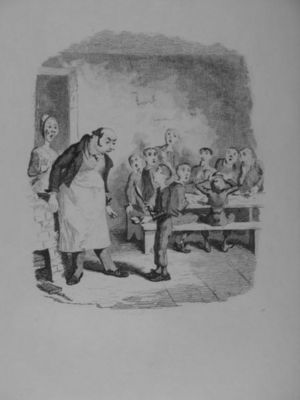Two of the most important themes of Charles Dickens’ “Hard Times” are one of true love, the other of maturity. Whether it is love for family, love for money, or love for the self the theme of true love recurs again and again throughout “Hard Times”. In this analysis, the major character developments of both Mr. Gradgrind and Louisa will be highlighted, while covering the scenes where Louisa’s decision to marry Mr. Bounderby are made. As well, Chapter XV of Book I will be compared with Chapter XII of Book 2 to show this character development and maturing in Louisa from shy and passive girl to a more well rounded character. Also, the confrontation between Louisa and Mr. Gradgrind involving Louisa’s wish to experience growth outside of her marriage to Mr. Bounderby, will be explored for deeper meaning and looked at with a directorial eye. The directorial eye will be used to expand on Charles Dickens’ theme of true love while showing Louisa’s change into an independent woman. Also, some of the dialogue will be discussed and altered between father and daughter in Chapter XII of Book 2.
The concept of love comes through strongly throughout the story but especially in Chapter XII of Book 2 where Louisa with honesty and utter despair relates to her father her repressed feelings of anger. Dickens’ use of parallel structures or the recurrence of themes brings forth his most important messages throughout the novel and this is done with the concept of true love. By using parallel structures it becomes clear that Louisa is sacrificing her own inner happiness by offering to marry Mr. Bounderby. It is a tribute to Charles Dickens’ mastery of writing when he makes it clear to the reader; that happiness can only be found in true love while anything else will lead to heartache and misery.
Louisa states “Father, I always knew it. In this strife I have almost repulsed and crushed my better angel into a demon” (Dickens 217).
This reference relates Louisa’s complete unhappiness in her marriage to Mr. Bounderby. As well Louisa goes on to say “…the ordinary deadened state of my mind as I know it-you proposed my husband to me. I took him” (Dickens 217).
It almost seems like Louisa is having an early mid-life crisis here as she finally opens her eyes to the mistakes that she has made by marrying Mr. Bounderby. This is a great breakthrough in Louisa’s character to show such impassioned emotion in contrast to earlier in the book where Louisa is described by Mr. Harthouse as “…ill at ease…” (Dickens 129) while in the presence of Mr. Bounderby and often as emotionless (Dickens).
Later Tom states that Louisa did not wish to marry Mr. Bounderby and did it only to help Tom with his finances (Dickens 133). This description of Louisa’s character alludes to Louisa’s innocence, caring nature, self-sacrifice, and immaturity in her decision to marry Mr. Bounderby.
In order to give a thorough analysis and show the reason for Louisa’s passionate breakthrough in front of her father during Chapter XII of Book 2, it must be linked with her agreement to marry Mr. Bounderby in Chapter XV of Book I. Mr. Gradgrind, without emotion, relays Mr. Bounderby’s desire to marry Louisa and Louisa passively accepts the offer while foregoing her own inner desires. This scene shows an inner conflict that is taking place within Louisa. One part of her wants to please her father and do right by her family while another wants to pursue her own happiness. This is actually an example of reverse utilitarianism where Louisa is not actually pursuing her own happiness but is satisfying the desires of her father. There are several instances where Mr. Gradgrind offers Louisa an opportunity to speak up or dismiss the proposal of marriage, but she sits passively by as if she has no choice in the marriage.
Instead of asserting herself Louisa responds by stating “Father,” said Louisa, “do you think I love Mr. Bounderby?” and “Do you ask me to love Mr. Bounderby?”
If Louisa did not wish to marry Mr. Bounderby the time would be now, to speak out Instead she lets her father decide for her. It could be said that societal pressure, her brother Tom’s financial woes, innocence, and Louisa’s desire to make her father happy are what drives Louisa to say yes to Mr. Bounderby. This bowing to external pressures is what creates Louisa’s unhappiness through most of the book. There are other allusions to Louisa’s despair including a scene where Louisa goes to visit with her dying mother “… (Louisa) had thought that her sister’s was a better and brighter face than hers had ever been…” (Dickens 199)
It seems that Louisa is jealous of her sister’s capacity for emotion and playfulness while denying those parts within her self. It could have been simpler if Louisa had spoken out about her apprehensions to marry Mr. Bounderby earlier, rather than later in the story. However, this would have reduced the character development of Louisa and strength of dialogue in “Down.”
Charles Dickens in Chapter XV of Book I highlights Mr. Gradgrind’s belief that Louisa is a rational being without passions while leaving out the duality of Louisa’s character that is also caring, innocent, and deeply wise (96).
Mr Gradgrind describes his daughter as “…non impulsive, you are not romantic, you are accustomed to view everything from the strong dispassionate ground of reason and calculation” (Dickens 96)
This is Dickens use of the negativity capacity which is the ability to hold two opposing characteristics at the same time. Louisa is in fact rational and dispassionate at times while also being passionate, romantic and perhaps even impulsive at other times. This is shown later in Chapter XII of Book 2. It is these two different Louisa’s, one who is passive in Chapter XV of Book I and another who is passionate, mature, and still innocent in Chapter XII of Book 2, that create a whole, complex character. This shows Dickens’ ability to create multi-dimensional characters that over the course of a book change and evolve, along with the story.
Now, a directorial eye will be added to XV of Book I and Chapter XII of Book 2 to emphasize Dickens’ themes of utilitarianism and the growth of Louisa into womanhood. As “Father and Daughter” begins, the camera would be positioned above Mr. Gradgrind’s shoulder, with Louisa in the background. This would stress Mr. Gradgrind’s position as a domineering authority figure. Louisa would have her hair back, without make-up and appear quite young to highlight Louisa’s innocence. As the dialogue progresses and the marriage proposal is spoken the camera would focus on Louisa’s expressions and capture any emotional responses.
After Mr. Gradgrind states “Louisa, my dear, you are the subject of a proposal of marriage…” and “…Mr. Bounderby has made his proposal of marriage to me…” (Dickens 97). An expression of fear and shock would cross Louisa’s face briefly; her face would blanch, and then change to an expression of solemnness. This type of character acting would require the gifts of Natlie Portman or Spencer Locke.
While the scene ends the camera would follow Louisa to a coat rack where she would choose a black overcoat and exit the house into a winter snow. Louisa’s choice of a black coat would symbolize her mourning and loss of innocence. As Louisa leaves the house a slight blue tint would be added to scenes to show Louisa’s feeling of melancholy. As well, in most scenes Louisa would appear in black clothing, to again show her grief and hint at her loss of innocence.
In Chapter XII of Book 2 the strength of the dialogue holds the scene but there are a few techniques that could be added, by a director, to accentuate themes like the use of character personas and Louisa’s development into independence. As the scene begins Louisa would walk across a bridge representing her new found connections within her self and her strengthening of character. The lightning would continue but the season would be spring which would represent the possibility of new beginnings. Despite the darkness of night flowers would appear as Louisa approaches the house. While Louisa discusses her unhappiness the camera would take a more neutral position and highlight both characters in the shot, thereby showing an equality between father and daughter. In the background, a window would be seen and show the lightning crashing outside. The use of lightning often represents impending conflict. However, in this case the lightning would represent Louisa’s inner illumination and show that she is now on a path of truth and happiness. As Louisa removes her jacket she would be wearing a bright red dress which would emphasize her inner passions and growth into full womanhood.
Also, the room would be somewhat dark to allow for a reflection of the fire off of Louisa’s eyes to match up with the dialogue “…(Mr. Gradgrind) saw a wild dilating fire in the eyes steadfastly regarding him” (Dickens 218)
Some of Mr. Gradgrind’s dialogue would be enhanced to create for a more equal conversation. Instead of “O no, no. No, Louisa” (Dickens 216). Mr. Gradgrind would reply “Louisa it was only with the greatest of intentions that I brought forth Mr. Bounderby’s proposal. I wanted to see you flourish not to become desolate.” This speech would be in response to Louisa’s previous dialogue of being doomed and hardened (Dickens 216). A more balanced dialogue would show Mr. Gradgrind’s love for his daughter more fully and paint him as a more caring, conflicted, and well rounded character.
The ending of Chapter XII of Book 2 would remain the same, with a small addition. As Mr. Gradgrind sees Louisa in a heap and realizes his system is a failure, (Dickens 219) he would remove his spectacles to show that he is now seeing his daughter clearly for the first time.
As well, the scene would end with Mr. Gradgrind saying to himself but out loud, “If only I wouldn’t have placed all my faith in logic.” Thereby, showing Mr. Gradgrind’s realization of his mistake. The scene would then fade to black and through future scenes any blue tint on the camera lens would be removed. Louisa’s character would be more expressive, while her Father would also speak from an open heart. Similar to “A Christmas Carol,” another Dickens’ classic. In the movie Scrooge has an inner awakening and begins to live life to its fullest through generosity of spirit.
In the end, “Hard Times” is a timeless classic not only for its character development but also for its use of themes. The themes of industrialization, maturity, true love, and social pressures were current in Dickens’ times and are still current today. This is what makes this novel more than a one time read as the deeper meanings of each character flow through the pages over time.
Works Cited
Dickens, Charles. Hard Times. New York: David Campbell Publishers, 1992.
Didactism. 14 Aug. 2008 .
Hard Times. 14 Aug. 2008 .
Hard Times. Internet Movie Database. 14 Aug. 2008
.




